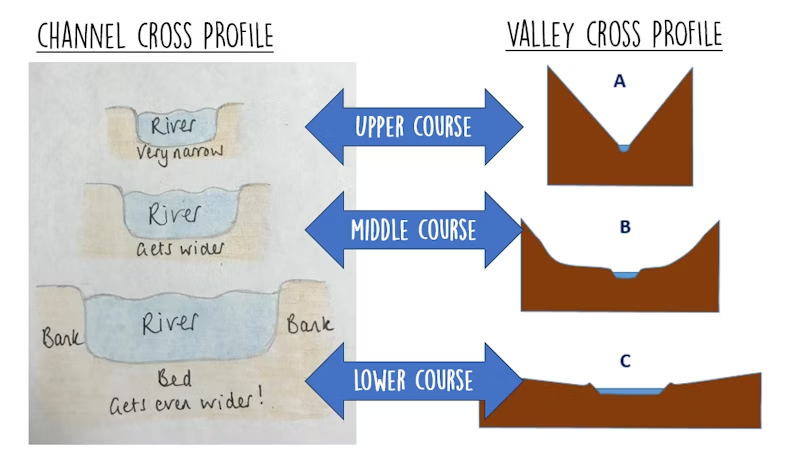Study Notes
GCSE Geography | The River Cross Profile (River Landscapes 3)
- Level:
- GCSE
Last updated 17 Oct 2024
The cross profile of a river is a section taken sideways across the channel or valley. There are two types of cross profile...
- Channel cross profile - only includes the river
- Valley cross profile - includes the channel, the valley floor and the slopes of the valley sides
How does the channel cross profile change as you move downstream?
The channel cross profile is a sideways look at the river only.
- In the upper course the channel cross profile is very narrow and quite shallow, this is because there isn’t a huge amount of erosion taking place, and this erosion is mainly vertical
- In the middle course the channel is starting to become deeper and wider – it is usually more than a metre deep
- In the lower course the channel becomes even wider and can actually be more than a kilometre wide for the biggest rivers in the UK. The river is also much deeper here too
Why does the channel cross profile change as you move downstream?
Hydraulic action and abrasion are the main processes of erosion in the upper course. As the river flows downstream the volume of water increases as many tributaries join the main channel, which increases the river's energy and its ability to erode, so it cuts a deeper channel as it flows downstream.
As the river flows downstream the gradient becomes less steep, meaning that there is less vertical erosion, and instead lots of lateral erosion. This sideways erosion eats away at the river banks, making the channel wider.

How does the valley cross profile change as you move downstream?
The valley cross profile is a sideways look at the channel, the valley floor and the valley sides.
- In the upper course the valley cross profile is steep sided, v-shaped, with a narrow valley. The valley is so narrow that the river channel will take up more of the valley floor
- In the middle course the valley cross profile becomes wider with more gently sloping sides – there is a small flood plain here
- In the lower course the valley cross profile is really wide, with a flat floodplain on both sides of the river channel. There may also be levees on the sides of the channel itself too
Why does the valley cross profile change as you move downstream?
In the upper course the valley has steep sides (v-shaped) caused by vertical erosion. Because the slopes are so steep there is a lot of weathered material that falls down the slopes and gathers on the valley floor, before being removed by the river. Rock tends to be much harder, and therefore resistant in the upper course so less lateral erosion happens, keeping the valley narrow with steep sides.
In the middle course the river's gradient is less steep so the river starts to erode laterally with meanders forming, making the valley wider. The rock here is softer so the valley sides erode, making them less steep. Lateral erosion needs more energy so there is not much left to remove all the weathered material, so it builds up on the valley floor.
In the lower course there is more deposition of material which builds up floodplains and widens the valley further.
You might also like
River Landscapes - GCSE MCQ Quiz
Quizzes & Activities
Physical Landscapes of the UK - GCSE MCQ Quiz
Quizzes & Activities
Tri-Dominoes - River Landscapes (Paper 1) | Revision Activity
Teaching Activities
Daily Email Updates
Subscribe to our daily digest and get the day’s content delivered fresh to your inbox every morning at 7am.
Signup for emails